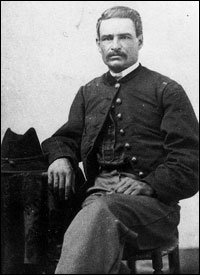
Taken circa 1864,
while serving as 2nd lieutenant.

Stephen Atkins Swails was born 23 February 1832 in Columbia, Pennsylvania. He was married and employed mostly as a waiter in Cooperstown, New York at the start of the American Civil War. However, his enlistment papers state he was employed as a boatman in Elmira, New York when he joined the army. On 23 April 1863, Stephen Swails enlisted in Company F, 54th Massachusetts, and was soon appointed the company's first sergeant. Due to the loss of men in the asault on Fort Wagner, Swails was appointed acting sergeant-major of the 54th on 12 November 1863.
During the Battle of Olustee, while still performing duty as the regiment's sergeant-major, Swails was wounded in the head soon after delivering a report to Colonel Hallowell. Setting out toward the Union supply point at Sanderson, he soon fell unconscious on the road, but was placed on a cart by 2nd Lt. Lewis Reed, one of the 54th's officers.
On 26 February 1864, Colonel Hallowell, "...In accordance with the desire of his officers as well as his own... recommended to Governor Andrew [of Massachusetts] that Sergeant Swails be commissioned in recognition of many soldiery qualities and his gallantry at Olustee."
On 26 March, the regiment received a list of promotions approved by Governor Andrew, one of which was Swails' promotion to 2nd lieutenant. However, in May 1864, while the regiment was posted on Morris Island, South Carolina, during the siege of Charleston, Swails' application to muster as a 2nd Lieutenant with the regiment was refused by the War Department. The reason given was "Lieutenant Swails' African descent." Colonel William Gurney, the post commander, ordered Swails to remove his officer's uniform and reassume duties as an enlisted man. However, Colonel Hallowell obtained a furlough for Swails and sent him, along with all the necessary paperwork, to Major General John Foster, commander of the Department of the South. Once there, Lieutenant Swails presented his case, and received General Foster's recommendation, which was forwarded to higher authority. Lt. Swails then returned to duty with the regiment. Finally, on 17 January 1865, orders were received from the War Department, authorizing Stephen Swails to muster as a 2nd lieutenant with the regiment, ending almost a year-long struggle on his behalf by Colonel Hallowell, Governor Andrew and the officers of the 54th. During this period, Swails continued to perform his duties as a line officer in Company D and participated in numerous actions.
On 11 April 1865, near Camden, South Carolina, Lt. Swails was wounded for a second time. While the 54th was on reconnaissance near a railroad junction, several locomotives, one with the steam up, were observed after dark. A detachment led by Lt. Swails rushed the trains and captured them. As Lt. Swails entered the cab of one locomotive, he waved his hat in triumph. However, sharpshooters deployed to shoot the trainmen if they tried to escape, mistook him for a engineer, fired and wounded him.
Second Lieutenant Swails was promoted to 1st lieutenant on 28 April 1865 and discharged on 20 August 1865, when the regiment mustered out at Boston.
After the war, Swails worked as an agent for the Freedman's Bureau, became a lawyer and lived in the South, becoming active in the political life of South Carolina. He was the mayor of Kingstree, where he lived from 1868 to 1879. He served as a state senator for ten years (1868–1878), including three terms as president pro tem.
Swails was a delegate to the 1868, 1872 and 1876 Republican national conventions. He became a member of the U.S. Electoral College, and also edited a newspaper, the Williamsburg Republican.[1][8]
He was forced out of politics after Reconstruction. After a white mob tried to assassinate him, he resigned from office and, through his Republican connections, obtained jobs in Washington, D.C. with the U.S. Postal Service and the Treasury Department.
Stephen Swails is buried in the Friendly Society Cemetery, Charleston, South Carolina.
Editor's Note:
The above information obtained from A Brave Black Regiment: The History of the 5th Massachusetts, 1863-1865 by Captain Luis R. Emilio. Just in case someone thinks I may have plagarized the Wikipedia (WP) article on Stephen Atkins Swails, check the WP article's history by clicking on "View history." I wrote most of the WP article, then copied what I wanted to post here.
External Links
Wikipedia page on Stephen A. Swails
Return to the 54th Massachusetts page.
Battle of Olustee home page
http://battleofolustee.org/